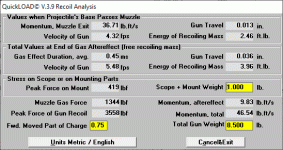An even simpler way to explain it is that to achieve a given velocity or a given peak pressure with a given powder class*, charges get larger as the powders get slower, which means there is more material to make gas. More gas produces more pressure in the combined barrel and chamber volume, and therefore pressure measured at the muzzle is higher.
The SAAMI method of recoil calculation I linked to and the online calculator you linked to use the same approximation method employed by the fellow in the article you linked to. It has limitations as to bullet velocity. This is revealed when the article author claims a 17 Remington can have 89% of its recoil come from rocket effect. In an example from Hodgdon's site, a 15.5-grain bullet over 27.2 grains of StaBall6.5, the bullet energy was almost 17% of the total energy stored in the powder. So even if it didn't lose over half that powder energy to heating up the case and the inside of the rifle barrel, as you normally do, there isn't 89% of the powder energy left to add recoil energy after the bullet gets 17% of it.
Here is where the SAAMI recoil calculation for high-velocity bullets go off track: Notice the method wants you to use either 4000 ft/s of escaping muzzle gas velocity or a multiplier of 1.75 times the bullet velocity to express gas muzzle velocity. If you divide 4000 by 1.75, you get a bullet velocity of 2,286 ft/s. That's a good 30-30 velocity. But it is the only velocity at which those two factors are simultaneously true. Everywhere else, one of them is wrong to some degree. In real life, as the bullet goes faster, the 1.75 number has to shrink because, like pushing a bullet through the air, the faster the expanding gas tries to go, the harder it has to push air out of the way, and this limits its velocity, making the multiplying factor smaller.
In the instance of that Hodgdon 17 Remington load, above, the muzzle velocity is 4857 ft/s is already beyond the 4000 ft/s estimated gas escape velocity for small arms (a good indication you are in a velocity realm not covered by the single-value SAAMI factors). The recoil calculator in QuickLOAD, which takes into account the actual muzzle pressure, the pressure gradient between the chamber and the muzzle, and the acceleration of the gas, puts the rocket effect at just over 50% of recoil for this combination, which is a lot easier to swallow. I got it up to 51% with the Hodgdon load of 27.4 grains of CFE 223 under a 20-grain bullet. But the rest were all lower.
*similar energy content similar per unit weight.

